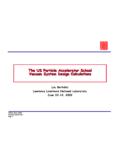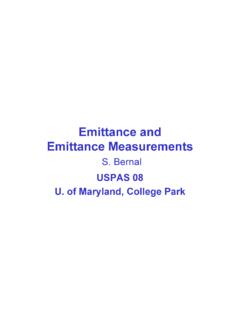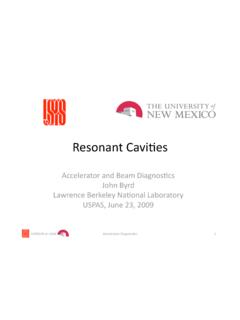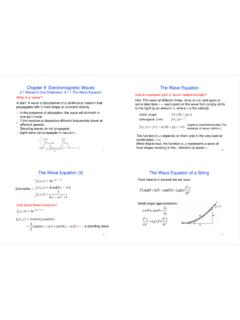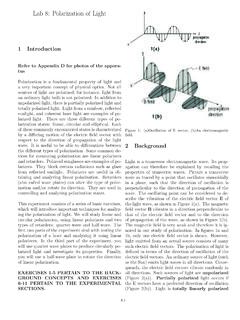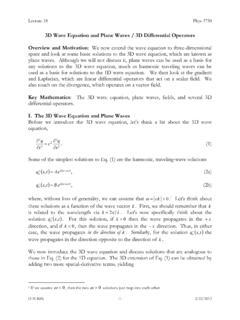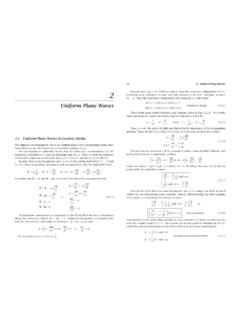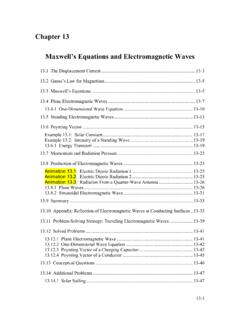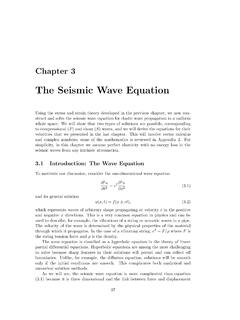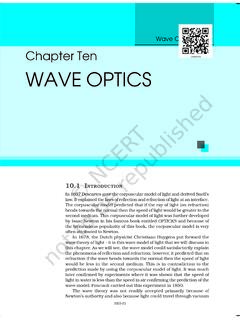Transcription of Maxwell’s equations • Wave equations • Plane Waves
1 Massachusetts Institute of Technology RF Cavity and Components for Accelerators 1 Massachusetts Institute of Technology RF Cavity and Components for Accelerators USPAS 2010 Maxwell s equations Wave equations Plane Waves Boundary conditionsA. Nassiri -ANLL ecture1-ReviewMassachusetts Institute of Technology RF Cavity and Components for Accelerators 2 Maxwell s EquationsThe general form of the time-varying Maxwell s equations can be written in differential form as:0= = = += BDBEDJH ttMassachusetts Institute of Technology RF Cavity and Components for Accelerators 3A few other fundamental relationshipsH/m104 F/m,108548with ity)(permeabil and ity)(permittiv hereips"relationsh veconstituti" equation" continuity" law" sOhm'" 7012000 = === == = =.
2 HBEDJEJrrtMassachusetts Institute of Technology RF Cavity and Components for Accelerators 4A few other fundamental relationshipsMassachusetts Institute of Technology RF Cavity and Components for Accelerators 5A few other fundamental relationshipsMassachusetts Institute of Technology RF Cavity and Components for Accelerators 6A few other fundamental relationshipsMassachusetts Institute of Technology RF Cavity and Components for Accelerators 7A few other fundamental relationshipsMassachusetts Institute of Technology RF Cavity and Components for Accelerators 8A few other fundamental relationshipsMassachusetts Institute of Technology RF Cavity and Components for Accelerators 9A few other fundamental relationshipsMassachusetts Institute of Technology RF Cavity and Components for Accelerators 10A few other fundamental relationshipsMassachusetts Institute of Technology RF Cavity and Components for Accelerators 11 Integral form of the equations = D = SQsdD tBE = = SCsdtBdE 0= B = SsdB0 tDJH += += SCsdtDJdH Massachusetts Institute of Technology RF Cavity and Components for Accelerators 12 Wave EquationsIn any problem with unknown E, D, B, Hwe have 12 unknowns.
3 To solve for these we need 12 scalar equations . Maxwell s equations provide 3 each for the two curl equations . and 3 each for both constitutive relations (difficult task).Instead we anticipate that electromagnetic fields propagate as Waves . Thus if we can find a wave equation, we could solve it to find out the fields directly. Massachusetts Institute of Technology RF Cavity and Components for Accelerators 13 Wave equationsTake the curl of the first Maxwell:( )()22ttttt = + = + = + = HJHJEJEJH ()LHS on the use Now2 HHH 0 Massachusetts Institute of Technology RF Cavity and Components for Accelerators 14 Wave EquationsThe result is:JHH = 222t Similarly, the same process for the second Maxwell produces + = ttJEE 222 Note how in both case we have a wave equation (2nd order PDE) for both Eand Hwith fields to the leftof the = sign and sourcesto the right.
4 These two wave equations are completely equivalentto the Maxwell Institute of Technology RF Cavity and Components for Accelerators 15 Solutions to the waveequationsConsider a region of free space ( = 0)where there are no sources(J = 0). The wave equations become homogeneous:0222= tEE 0222= tHH Actually there are 6 equations ; we will only consider one Ex(z,t)2002222221 e wher01cvtEvzExx=== Massachusetts Institute of Technology RF Cavity and Components for Accelerators 16 Solutions to the wave equationTry a solution of the form f(z -vt) sin[ (z-vt)]. By differentiatingtwice and substituting back into the scalar wave equation, we find that it satisfies!f(z)t=0zf(z -vt1)t=t1zf(z -vt2)t=t2zMassachusetts Institute of Technology RF Cavity and Components for Accelerators 17 Plane Waves First treat Plane Waves in free space.
5 Then interaction of Plane Waves with media. We assume time harmonic case, and source free + EkE We require solutions for E and H (which are solutions to thefollowing PDE) in free spaceNo potentials here!(no sources)Note that this is actually three equations :zyxiEkzEyExEiiii,,==+ + + 020222222 Massachusetts Institute of Technology RF Cavity and Components for Accelerators 18 How do we finda solution?Usual procedure is to use Separation of Variables (SOV). Take one component for example Ex.( ) ( ) ( )002020=+ + + =+ + + =khhggfffghkhfggfhfghzhygxfExFunctions of a single variable sum = constant = -k02ckkkkkkhhkggkffzyxzyx ===++ = = = 2 with so and 020222222;;Massachusetts Institute of Technology RF Cavity and Components for Accelerators 19 Mathematical SolutionWe note we have 3 ODEs now.
6 Zjkzyjkyxjkxzyxehhkdzhdegkdygdeffkdxfd ==+==+==+ issolution 0 g issolution 0 issolution 0222222222()zkykxkjxzyxeAE++ =Massachusetts Institute of Technology RF Cavity and Components for Accelerators 20 But, what does it mean physically?()zkykxkjxzyxeAE++ =This represents the x-component of the travelling wave E-field(like on a transmission line) which is travelling in the direction of the propagation vector, with Amplitude A. The direction ofpropagation is given byzkykxkkzyx ++= Massachusetts Institute of Technology RF Cavity and Components for Accelerators 21 Physical interpretationThe solution represents a wave travelling in the +zdirection withvelocity c. Similarly, f(z+vt)is a solution as well. This latter solution represents a wave travelling in the generally,( )()()()[]vtzvtyvtxftzEx =,In practice, we solve for either E or H and then obtain theother field using the appropriate curl about when sources are present?
7 Looks difficult!Massachusetts Institute of Technology RF Cavity and Components for Accelerators 22 Generalize for all componentsIf we define the normal 3D position vector as:rkjzrkjyrkjxzyxCeEBeEAeEzkykxkrkzzyyx xr ===++= ++= similarly sothen zCyBxAEeEErkj ++== 00 where General expressionfor a Plane wave+sign droppedhereMassachusetts Institute of Technology RF Cavity and Components for Accelerators 23 Properties of Plane wavesFor source free propagation we must have E= 0. If we satisfythis requirement we must have k E0= 0. This means that E0is perpendicular to corresponding expression for Hcan be found by substitution of the solution for Einto the Eequation. The result is:EnkH = 00 Wherenis a unit vector in the Institute of Technology RF Cavity and Components for Accelerators 24 Transverse Electromagnetic (TEM) waveNote that His also perpendicular to kand also perpendicular toE.
8 This can be established from the expression for of propagationk,nNote that:knHE or = Eand Hlie on theplane of constantphase (k r = const)Massachusetts Institute of Technology RF Cavity and Components for Accelerators 25 Plane Waves at interfaces (normal incidence)Consider a linearly polarized (in x-direction) wave travelling inthe +z direction with magnitude EiEiHiErHrIncidentReflected 2 2 2 1 1 1 TransmittedzxArbitraryorientation!EtHtMa ssachusetts Institute of Technology RF Cavity and Components for Accelerators 26 Massachusetts Institute of Technology RF Cavity and Components for Accelerators 27 Metallic BoundaryMassachusetts Institute of Technology RF Cavity and Components for Accelerators 28 Metallic BoundaryDielectricMetalHESkin depthMassachusetts Institute of Technology RF Cavity and Components for Accelerators 29 Boundary conditionsWe deal with a general dielectric interface and two specialcases.
9 First the general case. For convenience we consider the boundary to be s equations in differential form require known boundaryvalues in order to have a complete and unique solution. The so called boundary conditions (B/C) can be derived by consideringthe integral form of Maxwell s 1 1 1 2 2 2 Massachusetts Institute of Technology RF Cavity and Components for Accelerators 30 General caseEquivalentEt1n 1 1 1 2 2 2Et2 Tangential E continuousn 1 1 1 2 2 2Ht2Ht1nx (H1-H2)=Jsn 1 1 1 2 2 2Bn1Bn2 Normal B continuousn 1 1 1 2 2 2D2nD1nn (D1-D2)= sMassachusetts Institute of Technology RF Cavity and Components for Accelerators 31 Special case (a) Lossless dielectricn 1 1 1=0 2 2 2=0Bn1=Bn2normal B fields continuousHt1=Ht2tangential H fields continuous (no current)Dn1=Dn2 normal D fields continuous (no charge)Et1=Et2 tangential E fields continuous)
10 Massachusetts Institute of Technology RF Cavity and Components for Accelerators 32 Special case (b) Perfect Conductorn 1 1 1=0 2 Perfect Electric Conductor Et2=Ht2=0Bn1= 0 Normal B(H) field is zero on 0 Tangential Electric field on conductor is H1=Js H field is discontinuous by the surface currentn. D1= Normal D(E) field is discontinuous by surface chargeMassachusetts Institute of Technology RF Cavity and Components for Accelerators 33 Boundary conditionsContinuity at the boundary for the tangential fields requires:(2) (1) tritriHHHEEE=+=+Fix signs whendefining impedance!211 :define NowZHEZHEZHE ttrrii= ==Substituting into (1) and (2) and eliminating Ergives 2122t coefficienon TransmissiZZZEEit+== Massachusetts Institute of Technology RF Cavity and Components for Accelerators 34 Plane Wave in Dispersive Media Recall the Maxwell s equations :vDBJDjBBjE = = + = = 0() ()()()BjEBEjtBez,y,xEtBEez,y,xEt;x,y,xEt jtj = = = = = 1 Massachusetts Institute of Technology RF Cavity and Components for Accelerators 35 Plane Wave in Dispersive Media Sofar,forlosslessmedia,weconsideredJ=0, and v=0 but,thereareactuallytwotypesofcurrentand oneofthemshouldnotbeignored.



